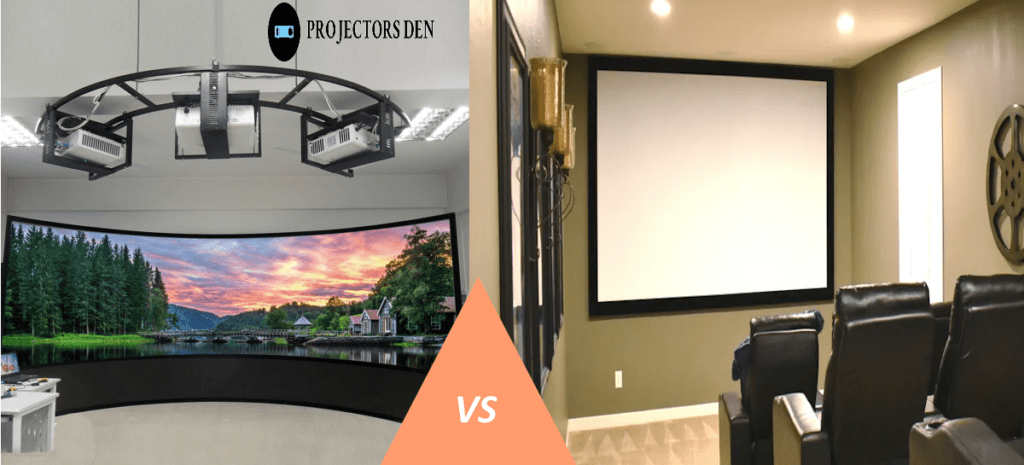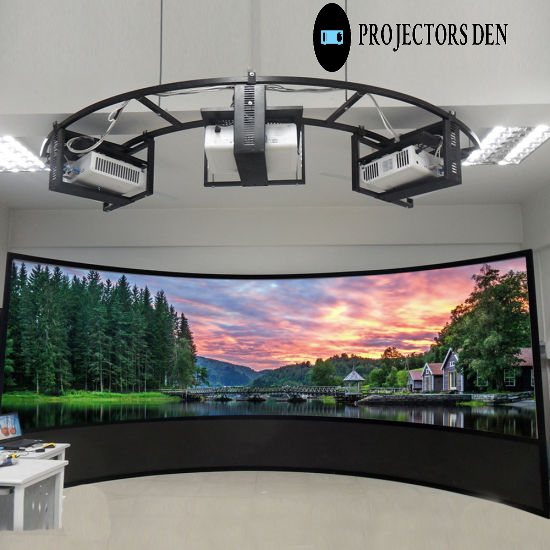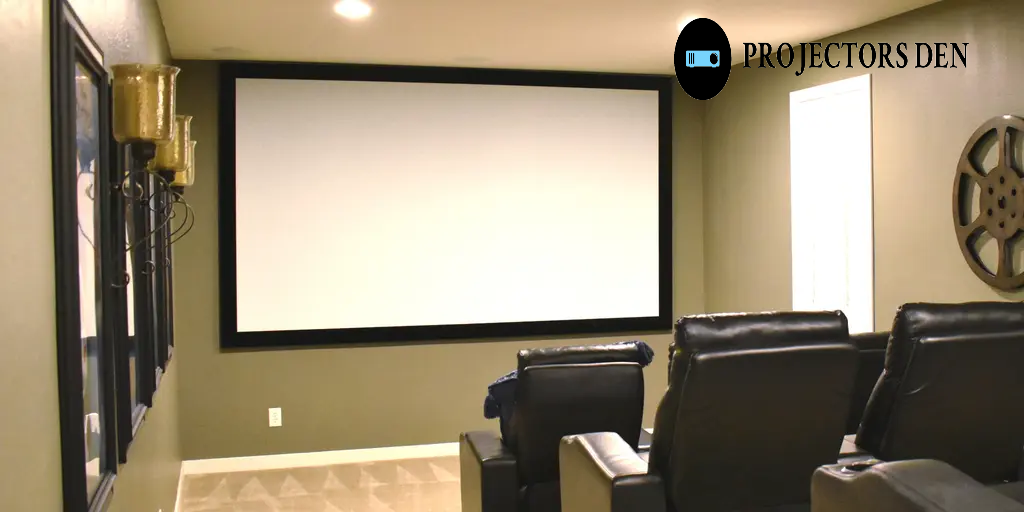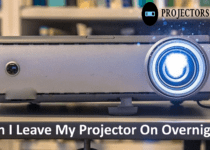Curved Projector Screen vs Flat

Curved screens, a recent innovation, are rapidly becoming popular in various industries like television and projector screens. They provide an immersive and expansive viewing experience that’s ideal for showcasing high-quality visuals on a grand scale.
In contrast, flat projector screens offer their own set of advantages, such as creating additional space in front of the screen and facilitating easy movement.
Therefore, what sets curved projector screens apart from their flat counterparts, and what are the pros and cons associated with each? Furthermore, how does the viewing experience differ between Curved projector screen vs Flat?
Curved Projector Screen vs Flat Screen
The discussion regarding the advantages of a curved projector screen as opposed to a flat one has persisted for an extended period.
Certain individuals assert that curved screens deliver an immersive sensation, as they enable images to envelop the screen’s contours.
Conversely, there are those who contend that curved screens are merely gimmicks, offering a wider viewing angle but without any noticeable enhancement in picture quality.
Meanwhile, a substantial number of individuals maintain the viewpoint that flat screens deliver superior picture quality and are also less susceptible to reflections.
Read more about Curved projector screen vs Flat.
Curved Projector Screen

Curved screens offer distinct advantages in terms of aesthetics and presentation, but they also come with certain drawbacks related to image quality.
If your priority is a screen that combines exceptional design with a superior viewing experience, a curved projector screen is an ideal choice. These screens are meticulously crafted to provide a seamless and immersive visual display.
They excel in delivering a captivating cinematic experience, ensuring no interruptions in visual or audio quality, especially during intense action sequences in movies or games.
Moreover, the curved design of the screen contributes to reduced eye strain, making it suitable for extended viewing sessions.
These screens truly shine when displaying images in the 2.35:1 aspect ratio or wider formats. Prior to their introduction, ultra-wide-angle images often suffered from loss of focus, prompting the development of curved projector screens to address this issue.
To fully embrace the wide-angle experience, opting for a curved screen of maximum size is advisable. This choice ensures sharp, bright images and an outstanding viewing experience.
Can I Connect Projector With Any Curved Screen?
Unfortunately, it’s not possible to connect your curved screen to just any projector. It’s essential to ensure that your projector is compatible with curved screen displays.
Curved screens demand a wider projection angle compared to regular flat screens, which means not all projectors are suitable for use with curved screens.
Typically, curved screens have a viewing dimension that goes beyond the standard 16:9 aspect ratio, often featuring a 2.35:1 aspect ratio.
It’s important to note that portable or budget-friendly projectors typically lack the capability to work seamlessly with curved projector screens.
Flat Projector Screen

One of the most widely used approaches for enjoying content is by using a projector. This represents one of the time-honored ways to view your favorite movies, whether on a wall or a flat surface.
Using a projector can create an ideal visual experience, especially when engaging in activities like gaming, which often employ a more conventional aspect ratio of 16:9 or lower.
Utilizing a projector provides a comparable experience to viewing content on a larger screen, as opposed to your regular television.
What’s particularly advantageous about a flat screen is its versatility in terms of setup, both indoors and outdoors within your home.
How To Keep Your Projector Screen Flat?
We all strive to maintain the projector screen in the flattest condition to ensure outstanding display quality. To achieve this, it’s essential to confirm that all four edges of your screen have the correct tension.
Additionally, it is advisable to handle the installation of your screen material onto the frame with great care to prevent any damage.
Curved Projector Screen vs Flat ( Which is more convenient )
Undoubtedly, curved projector screens offer a heightened level of immersion when compared to their flat counterparts. They enhance our perception of the three-dimensional world, providing a more convincingly stimulated sense of depth. Curved screens also bring benefits such as a broader field of view and reduced eye strain. However, it’s important to note that there are numerous aspects where flat screens surpass curved ones.
Can my projector work on a curved screen?
The frequency of maintaining your projector is contingent upon the environmental conditions and how frequently it is used. In general, it is advisable to conduct projector maintenance every few weeks or months. To maintain optimal performance, it’s essential to clean the projector’s lens and filter using a microfiber cloth and a specialized lens cleaning solution. Additionally, keeping the projector free from dust and debris is crucial.
It’s recommended to vacuum the area surrounding the projector and employ compressed air to dislodge any accumulated dust and dirt. Lastly, ensure that the cooling vents of the projector are unobstructed. If the projector operates in an environment characterized by extreme temperatures or excessive dust, more frequent cleaning may be necessary.
1. Crop and warp
Crop and warp are methods employed to modify the size, form, and orientation of digital images. Cropping involves eliminating undesired portions of an image, while warping alters the image’s shape. Both techniques allow for resizing and repositioning images, resulting in an ideal composition. However, it’s crucial to ensure that the image isn’t excessively distorted or stretched during these adjustments.
2. Anamorphic projector lens
An anamorphic projector lens is a specialized optical component employed to transform a standard 4:3 aspect ratio projector into a wide-screen format. Typically composed of two elements, these lenses horizontally expand the projected image, enhancing the immersion of the viewing experience.
Such anamorphic lenses are commonly integrated into home theater systems, enabling viewers to fully appreciate the cinematic grandeur of their preferred films. Furthermore, these lenses have the added benefit of reducing the size and weight of projectors, enhancing their portability.
3. Multiple projectors
The combination of multiple projectors can be employed to generate a unified expansive image. This approach frequently results in substantial, high-resolution visuals suitable for conferences, events, and exhibitions. Moreover, the utilization of multiple projectors can craft distinctive viewing encounters, such as images that envelop an entire room. To implement this technique successfully, specialized software and hardware are essential for configuring and fine-tuning the image, but the outcomes can be truly breathtaking.
Conclusion
When seeking the ideal projector screen to meet your requirements, it’s essential to weigh the advantages and disadvantages of curved and flat screens.
Before making a decision, take into account the dimensions of the space where you intend to install it and the level of ambient light present in the room.
If you have the budget and ample space and prioritize an immersive viewing experience, then opting for a curved screen is a viable choice.
However, for those who are budget-conscious, flat projector screens present a cost-effective alternative that also comes with numerous advantages.
Ultimately, it’s advisable to select the option that aligns with both your budget and specific needs.
Related Posts:


